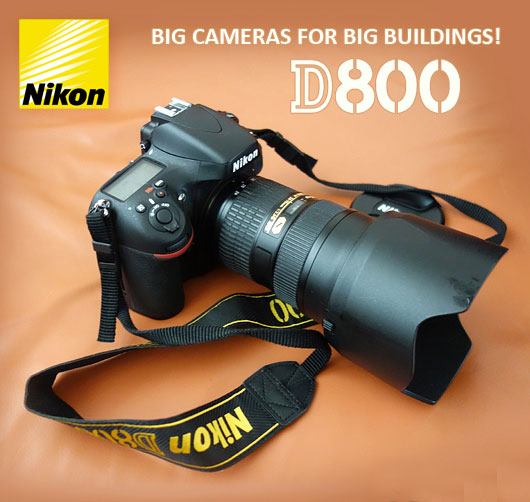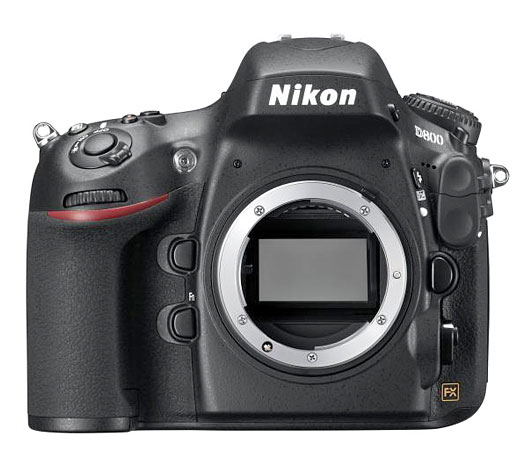Review Nikon D800 SLR Digital Camera Introduction:
Before the Nikon D800 was officially introduced last year, there were a lot of rumors going around about a new Nikon Full Frame camera with more than 30 megapixels. For many, it seemed too good to be true, since the now three-year-old Nikon D700 FX-camera has a ‘mere’ 12.1 megapixels. A successor was more than welcome among Nikon fans. With its 36 megapixels, the Nikon D800 is the world’s highest resolution full frame camera and is even a direct competitor of mid-sized cameras. The Nikon D800 is ready to use in no time. The camera is activated within 0.12 seconds, and the shutter lag has been reduced to about 0.042 seconds. At that speed, the D800 competes with its big brother, the D4. Nevertheless, the D800 is not an action photography camera. With the possibility of capturing a maximum of 4 images per second, this Full Frame camera is perfectly suitable for studio or landscape photography. This limits the D800’s target group, but that is understandable. The Nikon D700 was able to shoot 5 images per second. The competitor, the Canon, EOS 5D Mark III, is equipped with 22 megapixels and 6fps. Where the D700 and EOS 5D Mark III do not have a built-in flash, the D800 does come with an iTTL flash included. It performs well, in contrast to most flashes; the one on the D800 does not cause red eyes. Moreover, the built-in flash can also control external Nikon flashes, and it is able to use just the right amount of flash light, even in difficult lighting condition.
Nikon D800 SLR Digital Camera Features:
The Japanese camera manufacturer Nikon does not really view the D800 as the true successor to the D700. Nevertheless, there are a lot of similarities, especially if we look at the body. The durable camera body’s design with magnesium alloy has remained mostly the same. The body of the D800 is a bit compacter, it is lighter, and it is rounder. Despite the smaller dimensions, Nikon did take the opportunity to make the screen a bit bigger: from 3" to 3.2". The double card slot is also new, as the Nikon D800 supports both Compact Flash and SD memory cards. With the exception of the odd button that has changed locations, or the addition of a new button, the camera’s operation has remained the same. Nikon photographers will quickly know their way around the D800. Next to the higher resolution CMOS sensor, the Nikon D800 is equipped with a renewed and even more sensitive Multi-Cam 3500FX 51-point autofocus system. The viewfinder has 100% coverage and an additional virtual level. The integration of Full HD video is completely new in the Nikon D800 Camera Charger. With the D700, no videos could be recorded at all. Furthermore, the Nikon D800 has quite a few new technologies, such as the new Live View mode, 3D-color matrix metering, an RGB-sensor with 91k pixels, an HDR function, and the camera offers USB 3.0 support.
It is very enjoyable to shoot with the Full Frame Nikon D800, especially if you are used to Nikon’s button layout. The prominent handgrip ensures that the camera is very comfortable to handle, and that is necessary for a camera that weighs 900 grams and a set of two lenses that each weigh 900 grams as well. The image quality is overwhelmingly good, and the D800’s dynamic range is exceptionally big. The autofocus works well and the signal-noise ratio is excellent. Despite that the ISO sensitivity up to 25,600 is the same as in the D700, the D800 clearly performs better. Up to ISO 3200, you can easily take noise-free shots. For a camera such as the Nikon D800, it is very important to use high-quality lenses. When using standard lenses, it is not possible to get the most out of the Nikon D800 Battery Charger.
The 36.3 megapixel Nikon D800 Full Frame camera delivers exceptional, high resolution photos with breathtaking detail, beautiful, natural colors, and an enormous dynamic range. The camera only has a very limited amount of noise, and even performs exceptionally at higher sensitivities. The optical viewfinder’s 100% coverage, the improved autofocus system, and Full HD video support are all valuable additions. The Nikon D800 simply delivers fantastic image quality, and is equipped with the latest technologies, which we are to expect from a professional SLR camera in this price range. The only disadvantage of the D800 Nikon Camera Battery Charger is its shutter speed of 4 images per second. If you compare the camera with a medium format camera, which can only capture 1.5 frames per second, than you will soon reach the conclusion that it is actually a very fast camera for the amount of resolution it has to offer. If you are a professional landscape photographer or studio photographer that needs high-resolution, noise-free shots, then the Nikon 800 will be your perfect camera!
